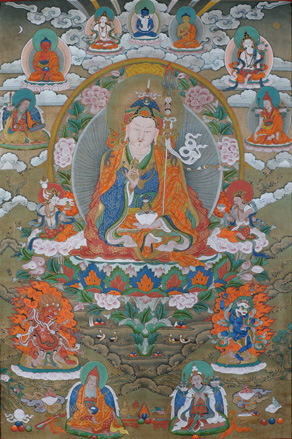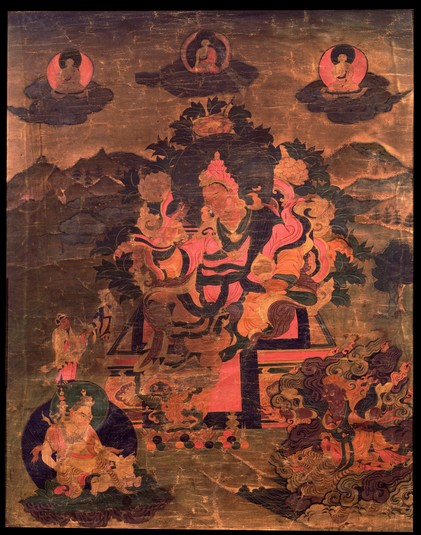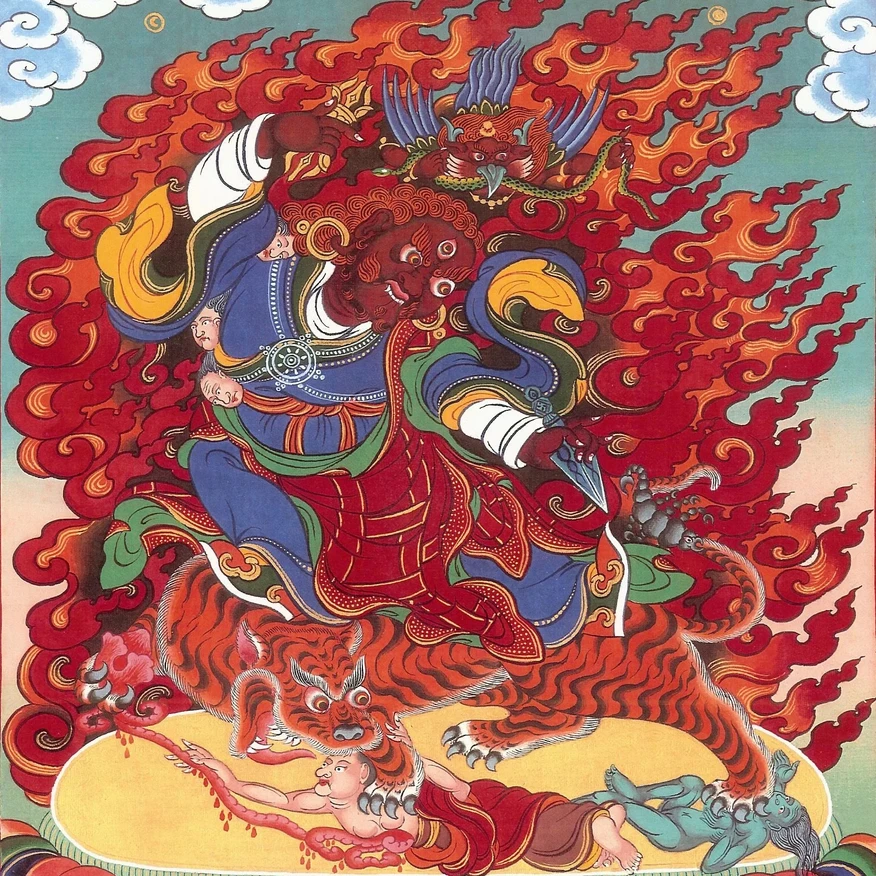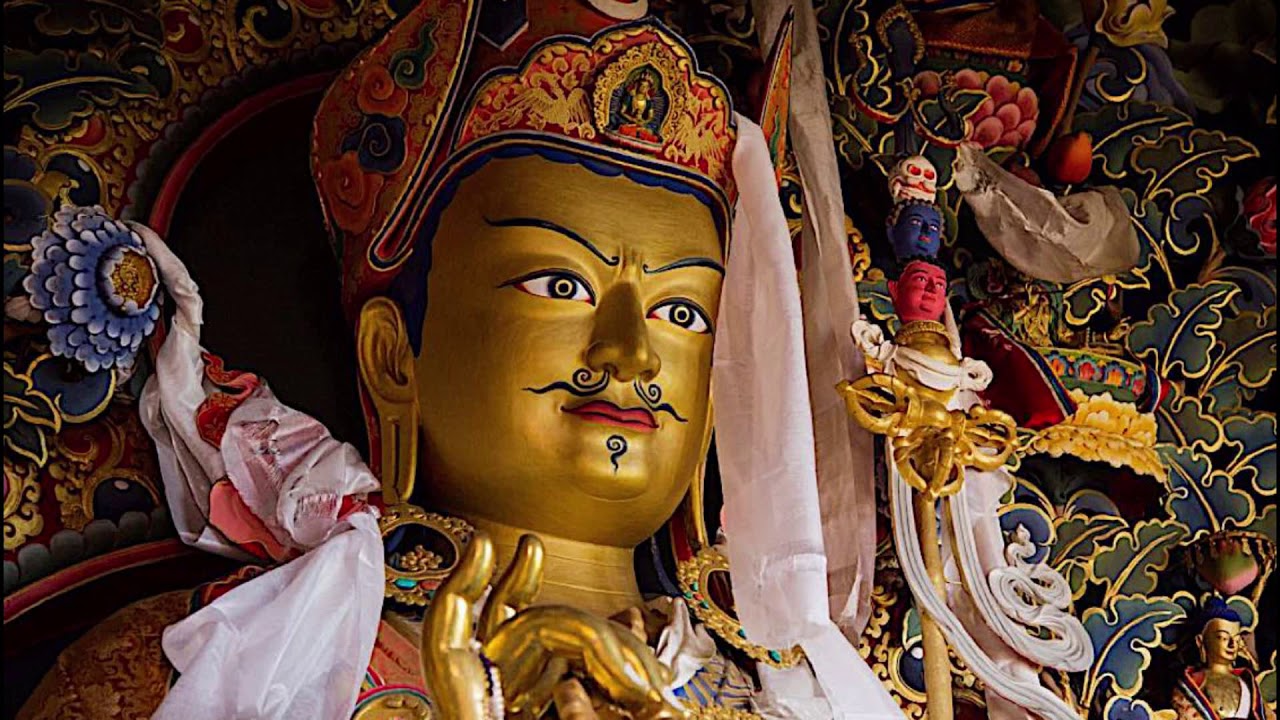Guru Padmasambhava, widely known among Tibetans as “Guru Rinpoche” or the “precious guru,” holds historical significance as the tangible founder of Tibetan Buddhism.
He is revered as the founder of the Nyingma school, the oldest school of Tibetan Buddhism, while maintaining immense importance across all other schools as well.
Having hidden hundreds of teachings and instructions as treasures, known as “Termas,” Guru Padmasambhava intended them to be revealed at an opportune time in the future. While recognizing that the present was not ripe for their dissemination, he foresaw their immense benefits for future generations. Over time, more than a hundred tantric masters have unveiled these treasures and diligently taught them to their students, as instructed by Padmasambhava, giving rise to the sacred Terma lineage.
The Mantra of Guru Rinpoche
OM AH HUM VAJRA GURU PADME SIDDHI HUM
OM stands for the body,
AH for the speech,
and HUM (or HUNG) for the mind
VAJRA signifies the embodiment of enlightened wisdom and compassion in its purest form, reflecting the Dharmakaya aspect of the Buddha—a transcendent deity embodying the ultimate truth.
GURU reflects the Sambhogakaya aspect of the Buddha, which is often referred to as the “bliss” or “enjoyment” body.
PADME embodies the enlightened mind, free from the shackles of ignorance, and corresponds to the Nirmanakaya aspect of the Buddha’s earthly body associated with the lotus family
Benefits of the mantra’s recitation:
“Even one hundred recitations per day without interruption will make you attractive to others, and food, wealth and enjoyments will appear effortlessly. If you recite the mantra one thousand, ten thousand, or more times per day, you will bring others under your influence with your brilliance, and blessings and powers will be continuously and unobstructedly obtained.”
OM AH HUM purifies obscurations of the three mental poisons.
VAJRA purifies obscurations of hatred and aversion.
GURU purifies obscurations of pride.
PADMA purifies obscurations of craving and attachment.
SIDDHI purifies obscurations of jealousy.
HUM purifies obscurations of delusion and disturbing emotions.
Eight Manifestations of Guru Rinpoche
The Eight Emanations of Guru Rinpoche exemplify his most benevolent actions for the welfare of all beings. They exemplify the remarkable adaptability of the true nature, allowing everything to manifest and continually transform without clinging to exclusive forms or dogmas. This flexibility reflects the boundless potential of Guru Rinpoche’s enlightened activities.
Different manifestations embody a transformative path of study, guiding individuals to cultivate wisdom step by step.
Manifestation #1: Guru Tsokyé Dorje

Guru Tsokye Dorje – Peaceful form of Guru Rinpoche
Time period: When Guru Rinpoche was 8 years old.
Deity: Directly related to Buddha Amitabha, the Buddha of the western direction.
Representation: Holding a vajra at his heart.
Location: The northwest of Bodhgaya in a kingdom known as Oddiyana. Oddiyana has always been considered a very mystical place and is praised throughout Vajrayana literature.
In the mystical land of Oddiyana, situated in the north-western part of the realm, a captivating spectacle unfolded on an island gracing the serene waters of Dhanakosha Lake.
The combined blessings of all enlightened beings materialized, taking the form of a resplendent, multi-coloured lotus flower.
Witnessing the profound suffering endured by sentient beings, the compassionate Buddha Amitabha emanated a golden vajra, adorned with the sacred syllable HRIH, which descended gracefully into the heart of the lotus. In a wondrous transformation, this divine vajra blossomed into the most exquisite and tender form of an eight-year-old child.
Within this celestial lotus, Guru Padmasambhava in a form of Guru Tsokye Dorje was born. In that sacred moment, the dakinis, emanations of enlightened energy, called out to Guru Padmasabhava with heartfelt devotion, and their supplication spontaneously coalesced into the resounding mantra of the Guru Rinpoche. This sacred mantra became the very core of the Guru Rinpoche’s being, resonating as his heart’s essence.
Manifestation #2: Guru Shakya Sengé
 Guru Shakya Sengé – a Self-Manifested Buddha.
Guru Shakya Sengé – a Self-Manifested Buddha.
Time period: Ordination of Guru Rinpoche
Deity: Buddha Shakyamuni – the Buddha
Representation: Buddha in monastic robes, holding an alms bowl in his left hand and a vajra in his right hand
Teachings: Awakening within this lifetime through discipline and detachment
During his second manifestation as the Buddha himself, Guru Padmasabhava received teachings, accomplished monastic the practice and passed through the various stages of spiritual realization.
Manifestation #3: Guru Nyima Özer
 Time Period: This represents the period when Padmasambhava resided in a charnel ground within the Indian kingdom of Baiddha, where he taught the dakinis for five years.
Time Period: This represents the period when Padmasambhava resided in a charnel ground within the Indian kingdom of Baiddha, where he taught the dakinis for five years.
Deity: He manifests as an embodiment of several great siddhas—masters who have attained a high degree of physical and spiritual perfection or enlightenment.
Representation: At times, he appears as a potent master of meditation, while also manifesting as a feeble-looking beggar or in various animal forms, all for the benefit of sentient beings.
Teachings: His teachings focus on awakening through meditation on love and compassion.
Guru Nyima Özer skillfully transformed outer and inner spirits, enlisting them as guardians safeguarding the precious Dharma. In reverence to these divine deeds, he came to be renowned as Nyima Özer, which translates to “Rays of the Sun”, illuminating the path of enlightenment for all beings.
Manifestation #4: Guru Padmasambhava

Time period: Came to Tibet in the 8th century and helped construct Samye Monastery, the first Buddhist monastery in Tibet
Deity: Present Buddha
Representation: wears a red monk’s hat, and sits on a lotus with his right hand in a mudra and left hand holding a skull-cup
Teachings: Transforming negative energy into more peaceful and compassionate forms
This emanation is about transforming negative energy into more peaceful and compassionate forms, developing the power, and expressing the inner urge of Guru Padmasambhava which is the heart of loving-kindness and compassion.
Manifestation #5: Guru Loden Choksé
 Time period: After departing from the kingdom of Oddiyana, Guru Rinpoche enters the realm of his manifestation as Bodhisattva Manjushri.
Time period: After departing from the kingdom of Oddiyana, Guru Rinpoche enters the realm of his manifestation as Bodhisattva Manjushri.
Deity: In this form, he holds a chod drum in his right hand and flowers in his left hand, symbolizing the profound teachings he imparts.
Teachings: His wisdom-filled teachings aim at dispelling ignorance and fostering the accumulation of wisdom through contemplation.
This manifestation demonstrates how to follow a course of study and learn to develop our wisdom step by step.
Guru Loden Chokse received the Dzogchen teaching known as the Empowerment of Awareness from Master Sri Singh, along with many different instructions, and mastered each one of them.
Manifestation #6: Guru Padma Gyalpo

Guru Padma Gyalpo – “Lotus King”, king of the Tripitaka.
Time period: Kingship. Guru Rinpoche was born just four years after the historical Buddha’s Mahaparinirvana, in the wood monkey year of the monkey month, in a kingdom known as Oddiyana. In the Tibetan calendar, monkey years are considered Guru Rinpoche years.
Representation: He is depicted with a reddish-pink complexion, displaying a semi-wrathful countenance while seated on a lotus and adorned in yellow-orange robes. In his right hand, he holds a small damaru, and in his left hand, a mirror and a hook. His top-knot is wrapped in white and adorned with streaming red silk.
Teachings: Guru Rinpoche represents the childlike state of non-duality, where distinctions of “this” or “that” dissolve, and a sense of freshness pervades. It embodies the removal of dualistic perceptions, facilitating a state of pure awareness.
Guru Padma Gyalpo openly demonstrates the splendor and magnificence of perception and conception when they’re completely free of ego-clinging and negative emotions.
Manifestation #7: Guru Sengé Dradrok

Time Period: After leaving the kingdom of Oddiyana.
Deity: He represents the collective power of all Buddhas. The lion-faced dakini Marajita bestowed upon him his wrathful mantra.
Representation: In a fiercely wrathful manifestation, Guru Rinpoche possesses a dark blue complexion, one face, and two hands. His intense gaze emanates from three piercing eyes, while his dark orange hair blazes upward. He holds a golden Vajra aloft in his right hand, and his left hand assumes a fierce gesture over his heart.
Teachings: Guru Rinpoche’s teachings focus on neutralizing irrational energies, black magic, curses, and hexes, as well as dispelling bad omens, weird vibes, and nightmares, offering protection from anything that might lead one astray.
Wrathful Form of Guru Rinpoche: He embodies the power to neutralize both visible and invisible beings, and to avert natural disasters, symbolizing the essence of a “Lion’s Roar.”
Manifestation #8: Guru Dorje Drolö

Guru Dorje Drolö is the wrathful form of Guru Rinpoche, depicted riding upon a pregnant tigress.
Time Period: This manifestation occurred right before Guru Rinpoche’s departure from Tibet, serving as a confirmation of his legacy of words and actions.
Representation: Typically depicted in paintings and sculptures, he appears in a wrathful form, with a maroon complexion, one face, and two arms. In his right hand, he holds a raised vajra scepter, while his left hand extends downward, grasping a three-sided ritual dagger.
Teachings: Guru Dorje Drolö is a meditational deity in Guruyoga practice, with at least fourteen different “terma” traditions associated with him.
To preserve the practice of Dharma in Tibet and secure the commitment of local spirits for future generations, Guru Padmasambhava emanated as Guru Dorje Drolo. In this form, he reaffirmed the power of his realization and ensured the support and submission of invisible beings.
Although incomprehensible to linear or chronological interpretations, all eight manifestations can simultaneously appear together or in many different places unlimited by any dualistic system of understanding.
6 must-reads on Guru Rinpoche
- Guru Rinpoche: His Life and Times by Ngawang Zangpo – Buy the book here
- White Lotus: An Explanation of the Seven-Line Prayer to Guru Padmasambhava by Jamgön Mipham – Buy the book here
- Padmasambhava Comes to Tibet by Yeshe Tsogyal & Tarthang Tulku – Buy the book here
- The Eight Manifestations of Guru Padmasambhava by Khenchen Palden Sherab Rinpoche. – Buy the book here
- Introduction to Tibetan Buddhism by John Powers – Buy the book here
- Dzogchen and Padmasambhava by Sogyal Rinpoche. – Buy the book here




